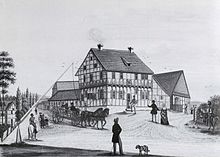Rüninger Tower
|
|
|
|---|---|
| The Rüninger Tower. The course of the Braunschweiger Landwehr is marked in blue. |
The Rüninger Tower was one of seven defense towers of the Braunschweiger Landwehr , the medieval, outer fortification of the city of Braunschweig . It was located south of the former city limits, in today's Rüningen district .
history
After the City Council in 1376 decided to build an outer defensive wall in the Brunswick region with the militia, far ahead of the actual city fortifications, one was around 1,385 dungeon built. The tower, first mentioned in 1400, was about four kilometers south of the city gates.
The tower was supposed to secure the important trade route between the cities of Braunschweig and Frankfurt am Main . Its location, today's Thiedestraße ( Bundesstraße 248 ) in Rüningen, was called Frankfurter Straße until the 20th century . Only in 1974, in the course of municipal reform in Lower Saxony , which runs at Rüningen part was Frankfurterstraße in Thiede street renamed.
During the frequent clashes between the city of Braunschweig and the dukes of the Principality of Braunschweig-Wolfenbüttel , the keep was destroyed several times. In 1492, the city council had it burned down in order not to give the tower into the hands of the ducal troops during a conflict with Henry the Elder (1463–1514).
In the 17th century, the Rüninger Tower was granted the right to serve guests on a commercial basis. To this end, a customs house was built in 1643 , where travelers could collect road money, a kind of toll .
In the 18th century the Landwehr and its towers lost their military importance. The tower was razed in 1724 . The customs house, a half-timbered building in the Renaissance style , was retained as an important customs post.
The customs house
In the course of the 19th century, the customs house also lost its importance and the once magnificent Renaissance building fell into disrepair. In the first half of the 20th century, the building had become increasingly dilapidated and also represented an obstacle to the developing modern road traffic.
After the Braunschweig city center was largely destroyed by Allied bombing attacks during the Second World War , at the end of the 1940s the desire arose to rebuild a half-timbered house in place of the destroyed Krambuden on the old town market , which had been on the north side of the Gewandhaus since 1470 . The customs house was then demolished, the richly decorated structural elements restored and reused for the new construction of the half-timbered house on the north wall of the Gewandhaus on the old town market.
literature
- Julius Reissner: The Landwehr in old Braunschweig . In: Braunschweig Calendar 1968 . Meyer, Braunschweig 1968.
- Carl Wilhelm Sack : The fortification of the city of Braunschweig . In: Archives of the Historical Association for Lower Saxony . Historical Association for Lower Saxony (Ed.), Verlag Hahnsche Hofbuchhandlung, Hanover 1847.
- Hans Adolf Schultz : The Landwehr of the city of Braunschweig. Their course in the light of the latest research . In: Braunschweigische Heimat . 40th year, volume 3, E. Appelhans & Co., Braunschweig 1954.
- Wilhelm Bornstedt : Chronicle of the pile village Rüningen - settlement geography, social, cultural and war history of a Brunswick village . Keddig-Druck und Verlag, Braunschweig 1980.
Web links
Individual evidence
- ^ Carl Wilhelm Sack: The fortification of the city of Braunschweig . P. 308.
- ↑ a b Hermann Kleinau : Historical Gazetteer of the country Braunschweig L-Z . In: Publications of the Historical Commission for Lower Saxony (Bremen and the former states of Hanover, Oldenburg, Braunschweig and Schaumburg-Lippe) . XXX: Historical directory of Lower Saxony . No. 2: State of Braunschweig . August Lax Verlagbuchhandlung, Hildesheim 1968, p. 495.
- ^ Wilhelm Bornstedt : Chronicle of the pile village Rüningen: settlement geography, social, cultural and war history of a Brunswick village . Braunschweig 1980, p. 233.
- ^ Friedrich Karl von Vechelde : Brunswick stories . Leuckart, Helmstedt 1835, p. 110.
- ↑ Erich Walter Lotz: The reconstruction of the Gewandhaus in Braunschweig . P. 12.
- ^ Günter Jahn: The old town market in Braunschweig - history and stories . In: Wolf-Dieter Schuegraf (Ed. On behalf of the city of Braunschweig): City archive and public library Braunschweig. Small Fonts No. 18 . 2nd Edition. Braunschweig 1998, p. 9.
Coordinates: 52 ° 13 ′ 27 ″ N , 10 ° 30 ′ 12 ″ E




